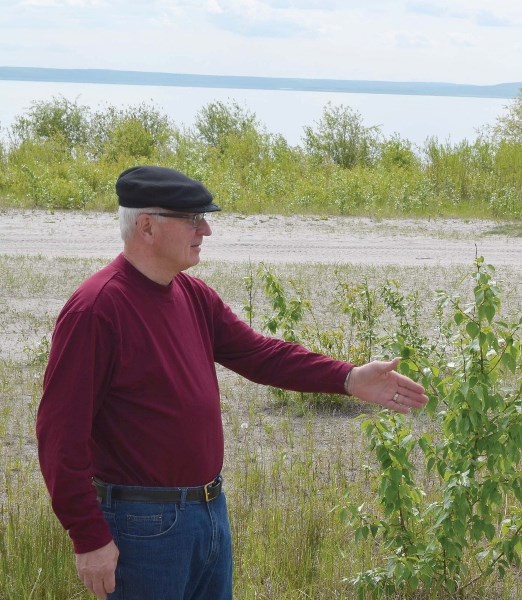For the past two decades residents in the Lakeland have been voicing their concerns over the decreasing water levels in Muriel Lake.
Today, the lake is half it's original size, has no fish in it, no wildlife around it, no recreational activities on it and has properties strewn with “for sale” signs, as residents want out.
“It is very, very sad,” said Peter Crown, who has owned property on the northwest side of the lake since 1978.
“When we first came here this was one of the better lakes in the whole region. It was clean and algae free. There was water flowing in and flowing out. We used to go ice fishing on this lake.”
Today, the deepest section of the lake is less than 15 feet deep, and that's only a small section. In the 1980's the lake deepest section measured over 30 feet deep, and was full of all types of fish. Today, the fish are all gone.
“Someone said to me the way it is going right now, with the water level where it is, in 10 years it will just be a hay field. That is disturbing,” said Crown.
Crown and other residents formed the Muriel Lake Basin Management Society (MLBMS) in 1999 to determine why water levels in the lake continued to decline with no sign of recovery. The group has been hard at work for over two decades, hiring people to study the lake and lobbying the government about the declining state of the lake.
It appears their concerns have fallen on deaf ears and politicians, government officials and many others in the province feel the only cause for Muriel Lake's demise is “mother nature”.
In July 2012 the government released a report and provided it to over 400 landowners living next to the lake. Their study concluded weather as the only factor in the water levels decreasing.
“We have been getting that answer from the provincial government for 20 years or so; it is just the weather. But when we look at the other lakes that were down and are now back up we think there has to be something other than weather taking place at Muriel Lake,” said Crown.
“The (government) says evaporative loss would have caused the lake to drop about 8 millimeters or so (last year), but the lake dropped 23 millimeters, so something else is going on that is stopping the water from getting back into the lake. There is something going on in the whole watershed that is bothersome.”
Last spring the MLBMS hired a pilot to fly over all of the creeks and streams that flow into Muriel Lake and found several instances where pipelines and industry service roads where blocking the water from flowing properly.
The group has also been in contact with the Alberta Energy Regulator (AER) after finding out that Baytex has been approved for it's third temporary license to draw water from a Muriel Lake aquifer. The group contacted the AER with their concerns and were “sloughed off” said Crown.
“Baytex is drawing water from a formation that isn't very far down beneath this landscape. They say the lake is not leaking into it but don't know if the formation is drawing water from all the creeks and streams around it,” said Crown. “We asked very detailed questions to them. Where is the recharge into the aquifer they are drawing from? They don't know. They just say there is lots of water.”
The AER says the aquifer Baytex is drawing from is deep enough and far enough away from Muriel Lake that it could not affect the water levels, as the pumping wells are located more than one township away from Muriel Lake.
“Our technical information indicates that withdrawals of groundwater from the two pumping wells listed on the temporary diversion license and license application will have no impact on water levels in Muriel Lake,” said AER communications officer Tracie Moore in an email to the Nouvelle.
Crown and the MLBMS don't buy it, and say Baytex refuses to answer their questions.
“If they could tell us where that water is coming from that is going in to that formation, that would answer a lot of our questions, but they don't have a clue and they wont answer the questions,” said Crown. “With my mapping background I would love to argue this in front of a judge.”
The Beaver River Watershed Alliance believe climate is a main factor in the decreased water levels, but say more caution should be taken when dealing with the lake.
“It is generally good philosophy to always look to see how we can ensure human development of all types isn't negatively effecting lake levels or lake water quality. I think that going forward, even though a lot of it is out of our control, I think it is good to look at what we can control,” said Harry Keess, BRWA Progam Manager.
Controlling what happens in and around the lake is a request that the MLBMS has bee asking for, for years.
“The thing that really gets me is that the government knows that this lake is suffering and at the same time they still let activity take place,” said Crown. “They talk so much about protection of habitat. One would think that if it is that sensitive they would just draw a line around the whole area and say until we really know what is going on nothing is going to take place in this area.”
The group plans continue to raise awareness about the condition of Muriel Lake and put pressure on the government until they get the answers they are looking for.
The MLBMS will be holding an annual general meeting at the Bonnyville Centennial Centre on July 13 at 10 a.m. to discuss the state of the lake and what action they would like to take next.



